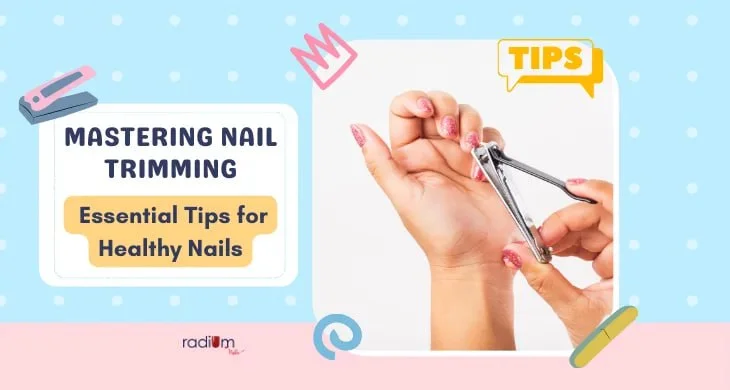Nail grooming is a crucial aspect of personal hygiene that extends beyond mere aesthetics. It plays a pivotal role in maintaining the health of your nails and safeguarding against potential infections. In this comprehensive guide, we delve into the intricate world of nail trimming, offering expert insights and invaluable tips to ensure that your nail grooming routine is both effective and safe. Through expert advice and practical strategies, we’ll equip you with the knowledge and skills needed to master the art of nail trimming. From selecting the right tools to adopting the correct cutting techniques, we’ll cover every aspect of nail grooming to ensure that your nails remain strong, healthy, and beautiful. Join us on this journey to discover the secrets of optimal nail care and unlock the key to maintaining pristine nails for years to come.
Why Nail Grooming Matters
Taking care of your nails isn’t just about making them look good—it’s also about keeping them clean and healthy. When your nails are trimmed properly, there’s less space for dirt and germs to hide, which means you’re less likely to get infections.
Think of it like tidying up your room. When everything is neat and organized, it’s easier to find what you need and keep things clean. The same goes for your nails. When they’re trimmed nicely, it’s easier to keep them clean and free from germs.
Trimming your nails regularly is a simple way to maintain good hygiene. It’s like brushing your teeth or washing your hands—it’s just something you do to keep yourself healthy. Plus, when your nails look neat and tidy, it can boost your confidence and make you feel good about yourself.
So next time you’re thinking about skipping your nail-trimming routine, remember that it’s not just about looks—it’s about staying healthy too. By taking a few minutes to trim your nails regularly, you can help prevent infections and keep your hands looking and feeling their best.
The Right Tools for the Job
When it comes to trimming your nails, having the right tools is super important. You’ll want to invest in good-quality nail clippers or scissors for your fingernails and a special clipper just for your toenails.
But it’s not just about having the right tools—it’s also about keeping them clean. Bacteria can easily grow on your nail clippers, so it’s important to disinfect them regularly. You can do this by soaking them in some rubbing alcohol or another disinfectant for a few minutes.
Once your tools are clean and ready to go, it’s time to start trimming. Make sure you’re in a well-lit area where you can see what you’re doing, and take your time. It’s better to trim your nails a little bit at a time than to try to do it all at once and accidentally cut too much.
When you’re trimming your fingernails, try to cut them straight across. For your toenails, it’s best to cut them straight across too, but you can also slightly round the edges if you want. Just make sure you’re not cutting them too short, as this can lead to ingrown toenails.
By following these simple tips and investing in the right tools, you can keep your nails looking neat and tidy while also preventing the spread of bacteria.
The Nail Trimming Process
Before you start trimming your nails, it’s a good idea to soften them up first. This makes the whole process easier and safer. One way to do this is by soaking your nails in some lukewarm water. You can also wait until after you’ve had a bath or shower, as your nails will be nice and soft from the water.
When you’re ready to trim, it’s important to know the right way to do it. For your toenails, you’ll want to cut them straight across. This helps prevent ingrown toenails and keeps them looking neat. For your fingernails, it’s best to cut them straight across too, but you can also round the edges slightly if you prefer. Just make sure you’re not cutting them too short, as this can be painful and may cause your nails to become ingrown.
Take your time when trimming your nails, and make sure you’re in a well-lit area so you can see what you’re doing. It’s better to trim them a little bit at a time than to try to do it all at once and accidentally cut too much. And remember, if you’re not sure what you’re doing or if you’re having trouble, it’s always a good idea to ask for help from a friend or family member.
Care for Cuticles
Cuticles might seem like a small thing, but they’re actually pretty important when it comes to keeping your nails healthy. They’re like little guards that protect the base of your nails, where they grow from. If you cut or push back your cuticles, you’re basically taking away that protection and making it easier for germs to get in.
That’s why it’s best to leave your cuticles alone. Don’t try to trim them or push them back, no matter how tempting it might be. It might seem like you’re making your nails look better, but you’re actually putting them at risk of infection.
Instead, focus on keeping your cuticles healthy. You can do this by moisturizing them regularly with a good hand cream or cuticle oil. This will help keep them soft and hydrated, which is important for their health.
If you do notice any changes in your cuticles, like redness, swelling, or pain, it’s important to see a doctor. These could be signs of an infection, and the sooner you get treatment, the better. In the meantime, try to avoid picking or biting at your cuticles, as this can make the problem worse.
Overall, the best thing you can do for your cuticles is to leave them alone and let them do their job of protecting your nails. Your nails will thank you for it!
Moisturize for Healthy Nails
Once you’ve finished trimming your nails, it’s time to show them some love with a little moisturizing. This step might seem simple, but it’s super important for keeping your nails healthy and strong.
When you trim your nails, it can leave them feeling a bit dry and brittle. Moisturizing helps to counteract that by keeping them hydrated and flexible. Think of it like giving your nails a big drink of water!
To moisturize your nails, you can use a hand cream or cuticle oil. Just dab a little bit onto each nail and gently massage it in. Pay special attention to the tips of your nails, as this is where they tend to get the driest.
Moisturizing is especially important if you live in a dry climate or if it’s winter time. Dry air can suck the moisture right out of your nails, leaving them prone to splitting and breaking. By keeping them moisturized, you can help prevent that from happening.
And don’t forget to moisturize regularly, not just after you trim your nails. Making it a habit to moisturize your nails every day will help keep them in tip-top shape.
So there you have it—moisturizing your nails is a simple but crucial step in your nail care routine. Don’t skip it! Your nails will thank you for it by staying strong and healthy.
Conclusion
Taking care of your nails is super important for keeping them healthy and strong. It’s not just about making them look pretty—it’s also about keeping them clean and preventing infections. By following these tips from the experts, you can make sure your nails stay in tip-top shape. Keep them trimmed and neat, and make sure you’re using the right tools for the job. And don’t forget to moisturize them regularly to keep them hydrated and flexible.
FAQs:
Que: How often should I trim my nails?
Ans: It’s recommended to trim your nails every 1-2 weeks, depending on how quickly they grow.
Que: Can I use regular scissors to trim my nails?
Ans: No, it’s best to use nail clippers or nail scissors specifically designed for trimming nails.
Que: What should I do if I notice changes in my nail color or texture?
Ans: If you notice changes in your nail color or texture, consult a dermatologist for evaluation.
Que: Is it safe to cut my own cuticles?
Ans: It’s not recommended to cut your own cuticles as it can increase the risk of infection.
Que: Can moisturizing prevent nail infections?
Ans: Moisturizing can help prevent nail infections by keeping the nails hydrated and healthy, but it’s not a guarantee.

